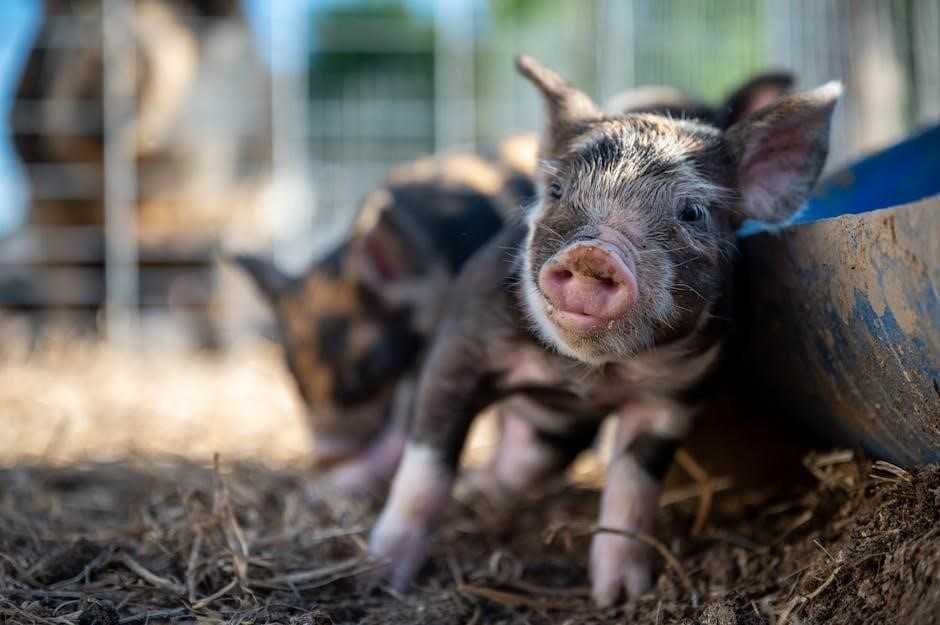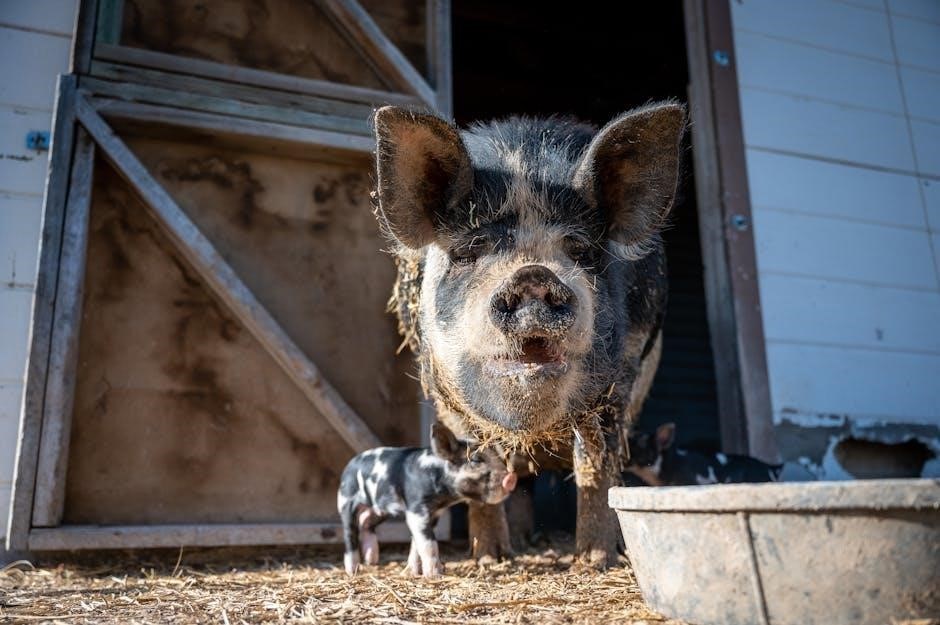The Three Little Pigs is a beloved fairy tale about three pigs building houses to outsmart a hungry wolf, teaching lessons on preparation and consequences.
Available in various PDF formats, the story remains a popular educational tool, highlighting themes of hard work, intelligence, and the importance of planning for the future.
Overview of the Classic Fairy Tale
The Three Little Pigs is a timeless fairy tale about three pigs who set out to build their own homes, facing challenges from a hungry wolf. The first pig builds a fragile straw house, the second uses sticks, and the third constructs a sturdy brick house. The wolf, determined to eat them, tries to blow down each house; Only the brick house withstands his attacks, teaching the pigs the importance of preparation and hard work. This story is widely loved for its simple yet profound moral lessons and has been adapted into various formats, including PDF versions for easy access and educational use.
Significance of the Story in Children’s Literature
The Three Little Pigs holds a special place in children’s literature as a moral guide, teaching life lessons through simple, engaging storytelling. Its themes of hard work, preparation, and consequences resonate with young minds, encouraging responsible behavior. The story’s repetitive structure and vivid characters make it accessible and memorable for children. Available in PDF formats, it serves as a valuable educational tool, helping teachers and parents impart essential values. Its enduring popularity highlights its universal appeal and effectiveness in shaping young readers’ understanding of cause and effect, making it a cornerstone of early childhood education and storytelling traditions worldwide.

The Origins of the Three Little Pigs
The Three Little Pigs is a classic fairy tale rooted in traditional folklore, first published in the 19th century, and widely available in PDF formats today.
Historical Background of the Fairy Tale
The origins of The Three Little Pigs are unclear, but the story is believed to have roots in traditional European folklore. It was first published in the 19th century and has since become a cornerstone of children’s literature. The tale reflects themes of survival, preparation, and outsmarting adversaries, resonating across cultures. Its simplicity and moral lessons have made it enduringly popular, with numerous adaptations available in PDF formats for modern audiences.
Historically, the story has been passed down through generations, emphasizing values like hard work and intelligence. Its timeless appeal continues to inspire new interpretations, solidifying its place in global storytelling traditions.
Authorship and Publication History
The exact author of The Three Little Pigs remains unknown, as it originated from traditional oral folklore. The story was first published in the 19th century, with one of the earliest known versions appearing in James Orchard Halliwell’s collection of nursery rhymes in 1842. Over time, it has been adapted and illustrated by various authors and publishers, becoming a classic in children’s literature. PDF versions of the story are now widely available, offering both free and paid editions for readers of all ages.
Its publication history reflects its enduring popularity, with modern digital formats ensuring its accessibility to new generations.
Cultural Variations of the Story
The Three Little Pigs has been reimagined across cultures, reflecting local traditions and values. In some versions, the wolf is replaced by other predators, while the pigs’ materials for building vary. For instance, a French-Canadian adaptation introduces themes of adulthood, exploring complex issues like adultery. Additionally, cultural sensitivity has led to changes, such as substituting pigs with puppies in certain performances. These variations highlight the story’s adaptability, making it resonate with diverse audiences. PDF versions of these adaptations are available, offering a glimpse into how different cultures reinterpret this timeless tale.
Such variations ensure the story remains relevant and engaging across different societies and generations.

Themes and Lessons from the Three Little Pigs
The story emphasizes hard work, preparation, and the consequences of laziness, while highlighting intelligence and resourcefulness as key virtues for overcoming challenges and achieving success.
Moral Lessons About Hard Work and Preparation
The story of the Three Little Pigs teaches the importance of hard work and preparation. The first two pigs, who hastily built their houses with straw and sticks, faced consequences when the wolf easily destroyed their homes. In contrast, the third pig, who diligently constructed his house with bricks, ensured his safety and success. This moral lesson emphasizes that effort and foresight lead to security and prosperity, while laziness and shortcuts often result in failure. The tale encourages children to value perseverance and thoughtful planning. PDF versions of the story further highlight these lessons, making them accessible for educational purposes.
Consequences of Laziness and Poor Planning
The story vividly illustrates the consequences of laziness and poor planning through the first two pigs. The first pig, who quickly built his house with straw, and the second, who used sticks, faced devastating outcomes when the wolf easily destroyed their homes. Their haste and lack of effort led to chaos and fear, forcing them to rely on the third pig for safety. The destruction of their houses serves as a clear warning about the dangers of shortcuts and negligence. In contrast, the third pig’s diligence highlights the rewards of careful preparation. PDF versions of the tale emphasize these lessons for young readers.
Importance of Intelligence and Resourcefulness
The third little pig exemplifies intelligence and resourcefulness by building a sturdy brick house, outsmarting the wolf and ensuring survival. His foresight and hard work contrast sharply with his brothers’ laziness, demonstrating how clever planning and effort lead to success. The story highlights the value of thinking ahead and using available resources wisely. The third pig’s ability to anticipate the wolf’s threats and prepare accordingly teaches children the importance of being proactive and resourceful. These qualities are central to the story’s moral, making it a timeless lesson in preparedness and ingenuity, as detailed in various PDF adaptations of the tale.

PDF Versions of the Three Little Pigs
The story is widely available in PDF formats, including free downloads, illustrated editions, and interactive versions for educational purposes, ensuring accessibility for diverse audiences worldwide.
Availability of Free PDF Downloads
Free PDF versions of The Three Little Pigs are widely available online, offering easy access to the classic tale for readers of all ages. Platforms like Google Books, educational websites, and digital archives provide downloadable copies, often with colorful illustrations and engaging layouts.
These free PDFs are ideal for teachers, parents, and students, serving as valuable resources for storytelling and lesson planning. Many versions are designed to be interactive, featuring clickable elements and animations to enhance the reading experience.
With just a quick search, users can find and download free PDFs of The Three Little Pigs, making it simple to enjoy or share this timeless story digitally. Its popularity ensures that free versions remain readily accessible online.
Paid Versions and Illustrated Editions
Paid versions of The Three Little Pigs offer enhanced features like vibrant illustrations, interactive elements, and higher quality formatting. These editions are available on platforms such as Amazon Kindle, Google Play Books, and Apple Books.
Illustrated editions often feature renowned artists, bringing the story to life with visually appealing designs. Some paid versions include additional content like puzzles, games, or educational activities, making them ideal for engaging young readers.
While free PDFs are accessible, paid versions provide a more immersive experience, making them a worthwhile investment for those seeking a premium storytelling experience.
Interactive PDFs for Educational Use
Interactive PDFs of The Three Little Pigs are designed to engage students with features like puzzles, quizzes, and clickable elements. These versions often include activities that enhance literacy skills and critical thinking.
Educators can use these PDFs to create interactive lessons, making storytelling a dynamic experience. They are ideal for classroom use or homeschooling, offering a fun way to teach moral lessons and promote active learning among children.

Characters in the Three Little Pigs
The story features three little pigs, each with distinct traits, and the Big Bad Wolf, who serves as the antagonist seeking to eat them.
The pigs’ choices in building materials—straw, sticks, and bricks—highlight their personalities and preparedness, while the wolf’s cunning drives the plot forward.
The First Little Pig: Traits and Decisions
The first little pig is often depicted as lazy or hasty, prioritizing quick results over quality. He builds his house out of straw, reflecting his lack of foresight.
His decision to use straw, the weakest material, demonstrates poor planning and naivety. This choice ultimately leads to his house being easily destroyed by the Big Bad Wolf.
Despite his flaws, the first pig’s story serves as a cautionary tale, teaching children the importance of hard work and preparation to avoid similar consequences in life.
The Second Little Pig: Characteristics and Role
The second little pig is often portrayed as slightly more ambitious than his first brother but still lacking in foresight. He builds his house with sticks, a marginally better material than straw, yet still vulnerable to the Big Bad Wolf’s efforts.
His role in the story highlights the concept of mediocrity and the consequences of not striving for excellence. While his house withstands longer than the first, it ultimately falls, teaching a lesson about the importance of diligence and proper preparation to avoid failure.
The Third Little Pig: The Cleverest Brother
The third little pig is depicted as the most intelligent and resourceful of the three brothers. He learns from the mistakes of his siblings and decides to build his house with bricks, ensuring maximum safety and durability.
His foresight and hard work pay off when the Big Bad Wolf attempts to blow down his house but fails. This character embodies the moral of the story, emphasizing the value of preparation, intelligence, and perseverance. His actions serve as a timeless lesson about the rewards of diligent planning and the consequences of laziness or poor judgment.
The Big Bad Wolf: The Antagonist’s Motivations
The Big Bad Wolf is the primary antagonist, driven by hunger and a desire to eat the three little pigs. His relentless pursuit of the pigs underscores his cunning and determination to satisfy his cravings.
As a symbol of danger and greed, the wolf’s actions highlight the importance of preparation and intelligence. His character serves as a contrast to the pigs, emphasizing the moral lessons of the story through his attempts to outsmart them and the eventual failure of his plans due to the third pig’s cleverness.

Adaptations and Interpretations
The story of the Three Little Pigs is widely available in PDF formats, offering various interpretations, from classic tales to modern spins, suitable for educational and entertainment purposes.
Movie Adaptations of the Story
The Three Little Pigs has been adapted into various animated films and series, offering fresh takes on the classic tale. These adaptations often feature vibrant visuals, engaging storylines, and memorable characters. For instance, The 3 Little Pigs: The Movie brings the story to life with modern twists, appealing to both children and adults. Additionally, live-action and CGI-animated versions have been produced, showcasing the story’s versatility. Some adaptations even blend humor with educational elements, making them suitable for classroom use. Fans can explore these films on platforms like Moviefone, where showtimes, reviews, and streaming options are available. The story’s enduring appeal ensures its continued presence in cinematic adaptations.
Theatre Productions and Stage Plays
The Three Little Pigs has been adapted into numerous stage productions, captivating audiences worldwide. These plays often feature vibrant costumes, dynamic sets, and engaging storylines. For instance, a French-Canadian production, The 3 Little Pigs, explored adult themes like financial struggles and marital issues through the story. In Yorkshire, a stage play replaced the pigs with puppies to accommodate cultural sensitivities. Theatre adaptations frequently blend humor with moral lessons, making them entertaining for both children and adults. These productions highlight the story’s versatility and enduring appeal, offering a fresh yet familiar experience for audiences of all ages.
Modern Retellings and Spin-offs
The Three Little Pigs has inspired diverse modern adaptations, blending traditional themes with contemporary twists. A French-Canadian production reimagined the story as a sex dramedy, addressing adult issues like financial struggles and adultery. Similarly, The 3 Little Pigs: The Movie offers a fresh cinematic take, appealing to new generations. Some versions introduce magical elements, such as 3 Little Pigs and the Magic Lamp, expanding the narrative’s imaginative scope; These retellings maintain the core lessons of hard work and cleverness while exploring fresh perspectives, ensuring the story’s relevance in modern media and entertainment.

Educational Uses of the Story
The Three Little Pigs is widely used in classrooms to teach moral lessons, encouraging critical thinking and problem-solving skills through engaging PDF materials and activities.
Lesson Plans for Teachers
Teachers can utilize the story of the Three Little Pigs to create engaging lesson plans, focusing on moral education and critical thinking. PDF versions of the story provide versatile resources for classroom activities, such as sequencing events, character analysis, and moral discussions. For younger students, activities like building houses with different materials can reinforce STEM concepts. Older students can explore themes of preparation and consequences through group discussions or creative writing. These plans promote teamwork, problem-solving, and a deeper understanding of the story’s timeless lessons, making it a valuable tool for educators across various grade levels.
Activities and Worksheets for Students
Engage students with interactive activities and worksheets based on the Three Little Pigs PDF. Sequencing events and character analysis exercises help develop comprehension skills. Word searches and crossword puzzles with story-related vocabulary enhance language learning. PDFs often include coloring pages and drawing activities, allowing students to visualize the story. Teachers can create comprehension questions or quizzes directly from the text. Creative writing prompts, such as rewriting the story from the wolf’s perspective, foster imagination. These resources cater to various learning styles, making the story a dynamic tool for educational engagement and fun for students of all ages.
Using the Story for Moral Education
The story of the Three Little Pigs is a timeless tool for teaching moral lessons to children. It emphasizes the importance of hard work, preparation, and responsibility. The first two pigs’ laziness and poor planning lead to consequences, while the third pig’s diligence and foresight ensure his safety. This narrative helps children understand the value of effort and the dangers of shortcuts. Teachers often use the story to encourage critical thinking about ethical choices and their outcomes. By adapting the story into classroom discussions or PDF-based activities, educators can foster moral development and ethical reasoning in young learners.

Multimedia and Digital Versions
The story is available in engaging PDF formats with animations, video clips, and interactive elements, making it a dynamic tool for modern storytelling and education.
Animated Films and Series
Animated adaptations of The Three Little Pigs bring the story to life with vibrant visuals and engaging storylines. Films like The 3 Little Pigs: The Movie and 3 Little Pigs and the Magic Lamp captivate audiences with colorful animations and catchy music. These productions often feature modern twists, blending humor and adventure to appeal to both children and adults. Streaming platforms offer easy access to these animated versions, making them a popular choice for family entertainment. Additionally, animated series and shorts provide fresh interpretations, ensuring the classic tale remains relevant in the digital age. These adaptations highlight the story’s timeless appeal and versatility.
Video Games Based on the Story
Video games inspired by The Three Little Pigs offer interactive fun and learning. Players can build houses, outsmart the wolf, and solve puzzles in various platformers and adventure games. These games often feature colorful graphics and engaging storylines, making them appealing to children and families. Some titles focus on educational aspects, teaching problem-solving skills and strategic thinking through gameplay.
Games like Three Little Pigs: Interactive Story and Big Bad Wolf: The Game bring the classic tale to life with modern twists. They are available on multiple platforms, including PCs, consoles, and mobile devices, ensuring accessibility for a wide audience. These games provide an innovative way to experience the story while promoting creativity and critical thinking.
Apps and Interactive Storytelling
Apps and interactive storytelling platforms have transformed The Three Little Pigs into engaging digital experiences. These apps often feature touch-interactive animations, voice narration, and sound effects, allowing children to immerse themselves in the story. Some versions include puzzles, quizzes, and games that reinforce the tale’s moral lessons about hard work and planning.
Interactive PDFs and apps also offer customizable story paths, enabling users to make choices that alter the narrative. This innovative approach fosters creativity and critical thinking while maintaining the story’s timeless appeal. Many of these apps are available for free or as paid downloads, catering to both entertainment and educational purposes.

Cultural Impact of the Three Little Pigs
The story’s timeless themes of preparation and consequences have made it a cultural phenomenon, inspiring films, ads, and educational tools, ensuring its relevance across generations.
Popularity in Children’s Media
The Three Little Pigs remains a staple in children’s media, with its timeless story of cleverness and perseverance captivating young audiences worldwide. Its engaging narrative, paired with vibrant visuals, makes it a favorite in animated films, TV series, and stage productions. The tale’s moral lessons, such as the importance of preparation, resonate deeply with both children and parents. Additionally, interactive PDFs and educational apps featuring the story provide innovative ways for kids to learn and enjoy the classic. Its adaptability to modern media ensures its enduring appeal, making it a cornerstone of children’s entertainment and education for generations.
References in Advertising and Marketing
The Three Little Pigs has become a cultural icon, frequently referenced in advertising and marketing campaigns. Its universal themes of preparation and cleverness resonate with audiences, making it a popular choice for brands. For instance, companies often use the story to emphasize strength and reliability, associating their products with the third pig’s brick house. Additionally, the tale’s moral lessons are adapted to promote values like planning and hard work. Its versatility allows marketers to creatively connect with consumers, ensuring the story’s relevance in modern advertising strategies while maintaining its timeless appeal across generations.
Influence on Other Fairy Tales and Stories
The Three Little Pigs has significantly influenced other fairy tales and stories, inspiring adaptations and spin-offs. Its themes of survival, strategy, and moral lessons have been echoed in various narratives. The story’s structure, featuring a trio of characters facing a common adversary, has been replicated in numerous tales. Additionally, the concept of building houses to withstand challenges has become a metaphor in other stories, emphasizing preparation and wisdom. The tale’s enduring popularity ensures its elements continue to shape new narratives, making it a foundational piece in children’s literature and beyond, as seen in its PDF versions widely used today.

Current Events and News
Recent movie releases and stage productions of The Three Little Pigs continue to captivate audiences, blending traditional storytelling with modern twists.
Cultural events, such as puppet shows and interactive performances, highlight the story’s timeless appeal, attracting both children and adults worldwide.
New PDF editions of the story are now available, offering enhanced visuals and educational tools for teachers and students to explore its lessons creatively.
Recent Movie Releases and Updates
Recent movie releases of The Three Little Pigs have brought the classic tale to life with modern twists, captivating audiences worldwide.
A new animated film adaptation, released in 2023, features stunning visuals and a fresh storyline, while live-action versions blend humor and adventure.
Additionally, stage productions like a French-Canadian dramedy and children’s performances in Yorkshire have reimagined the story for diverse audiences.
These updates ensure the tale remains relevant, offering entertainment and moral lessons for both children and adults, while PDF versions provide accessible storytelling options.
Stage Productions and Performances
Stage productions of The Three Little Pigs continue to charm audiences with vibrant performances and creative adaptations.
In Yorkshire, a children’s performance adapted the story to feature three little puppies, respecting cultural sensitivities while maintaining the tale’s essence.
Theatre productions often blend music, dance, and humor, making the story engaging for both children and adults.
With colorful costumes and dynamic sets, these performances bring the pigs’ adventures to life, offering a memorable experience for viewers of all ages.
Such adaptations highlight the story’s versatility, ensuring its timeless appeal on stage and beyond.
Contemporary Relevance of the Story
The story of the Three Little Pigs remains relevant today, offering timeless lessons on preparation, hard work, and intelligence.
Its adaptability to modern media, such as PDF versions and stage productions, ensures its continued appeal to new generations.
The tale’s themes of perseverance and cleverness resonate in today’s fast-paced world, making it a valuable tool for moral and educational purposes.
With its universal message, the story continues to inspire adaptations in film, theater, and digital formats, proving its enduring significance in contemporary culture.
The Three Little Pigs’ timeless tale continues to captivate audiences, with its lessons on preparation and wisdom remaining relevant in modern times through various PDF adaptations.
The Three Little Pigs captivates audiences with its timeless lessons on preparation, hard work, and outsmarting adversity. The story’s simplicity and moral clarity make it a favorite across generations. The characters’ distinct personalities—from the careless first pig to the clever third—offer relatable examples of decision-making. Its adaptability into various media, including PDFs, ensures its relevance in modern education and entertainment. The tale’s universal themes resonate globally, making it a cornerstone of children’s literature and a popular choice for teachers and parents seeking to impart life lessons. Its enduring appeal lies in its ability to entertain while educating.
Final Thoughts on Its Cultural Significance
The Three Little Pigs holds a cherished place in global culture, transcending generations with its timeless themes. Its influence is evident in films, stage adaptations, and educational materials, including PDF versions. The story’s universal lessons on hard work and preparation resonate worldwide, making it a staple in children’s literature. Its adaptability to modern media ensures its relevance in today’s digital age. The tale’s enduring popularity underscores its cultural significance, as it continues to inspire new adaptations and educational tools, cementing its legacy as a beloved and enduring story for audiences of all ages.


